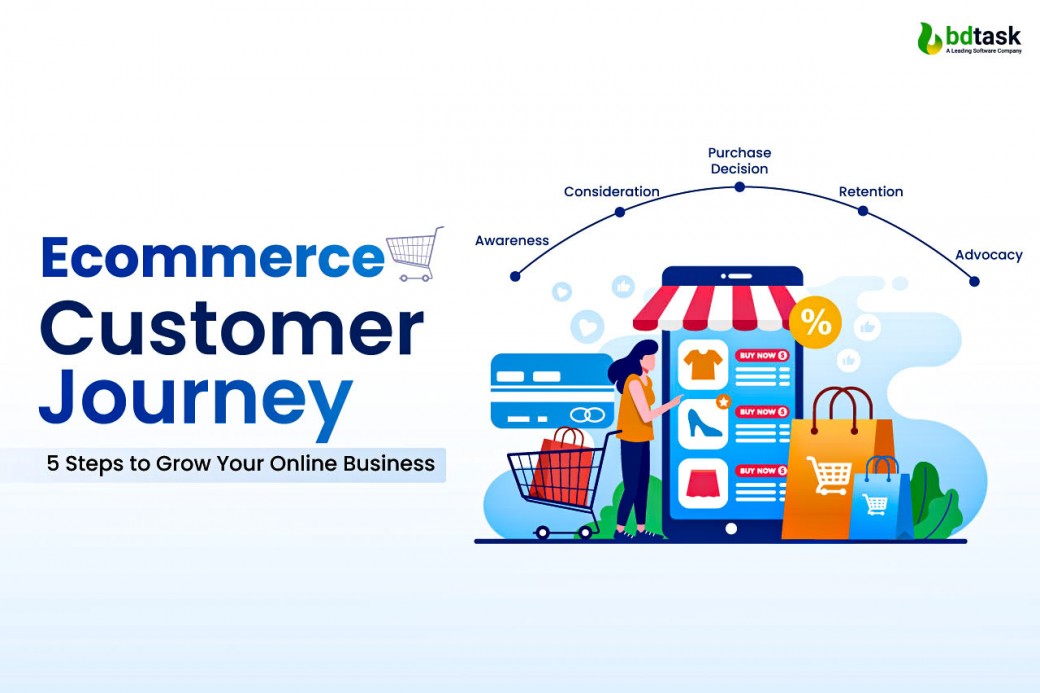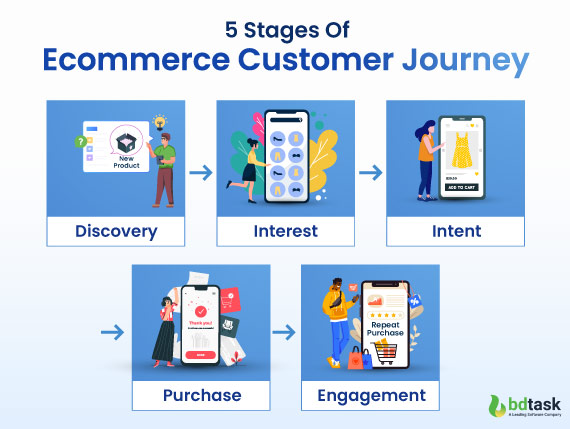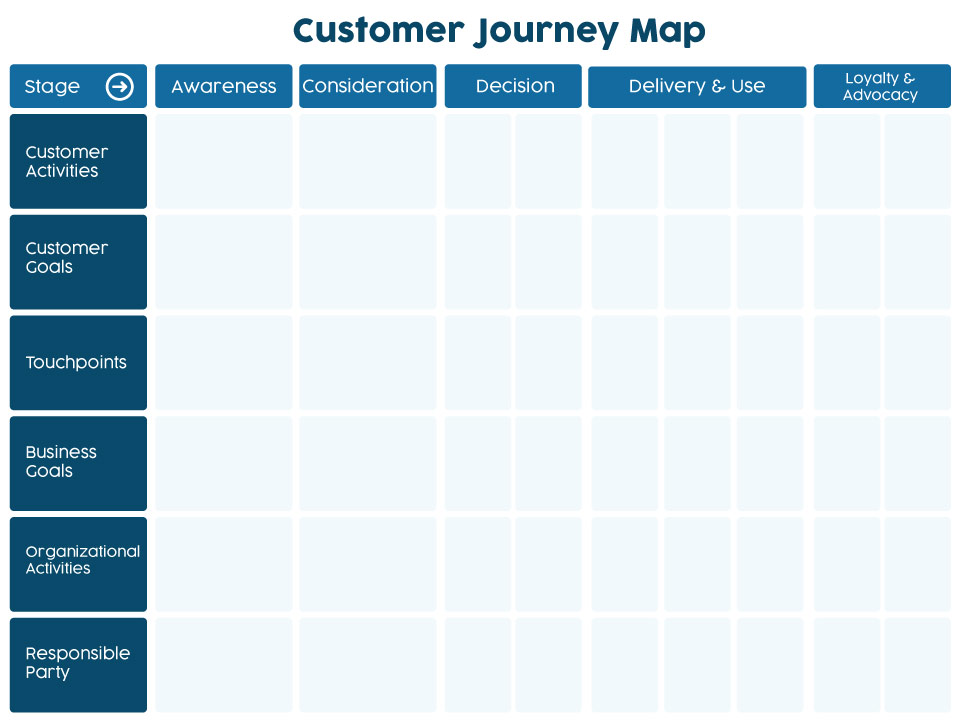Ecommerce Customer Journey: 5 Steps to Grow Your Online Business

Almost every seller's core concern is how to understand the ecommerce customer journey. As a solution, most sellers use different types of analytical tools to perceive the customers' intentions. In short, the ecommerce customer journey is a psychological game that uncovers the story of every purchase.
Providing the best customer experience is one of my primary targets while starting a business. Thus, it is better to be aware of the common and typical ecommerce customer journey map, before entering the ecommerce industry. Learning about eCommerce customer journeys helps track purchasing strategies and build customer engagement.
Honestly, it's very challenging to trace the customer journey, especially when it is an online business. It's very difficult to say the ecommerce customer journey is a linear graph (straight and moving upward). Because the whole journey consists of interacting and making micro-decisions at every different stage.
There Are 5 Stages Of Ecommerce Customer Journey:
- Awareness
- Consideration
- Acquisition
- Retention
- Advocacy
Thus, in this blog, I will discuss all the aspects of the ecommerce customer journey, showcase how you can draw an ecommerce customer journey map template and many more.
What Is Ecommerce Customer Journey?
In simple words, the ecommerce customer journey coveys all the steps & actions a potential customer experiences while using or interacting on an ecommerce website. This customer journey of ecommerce begins when a customer initially becomes aware of the product and ends when makes the final purchase. When a customer begins the journey and crosses the stages, it is called a customer touchpoint. Then, as this process flows, an e-commerce owner collects & uses those data to improve various aspects of the website.
Through ecommerce customer journeys, online business owners can analyse the customers' strategies, and psychologies, which are later utilised to build engagement and drive conversion.
Most ecommerce business entrepreneurs consider ecommerce customer experience metrics the only method for tracking & measuring customer satisfaction and boosting business success.
Ecommerce customer journey is a series of five stages that completely define how customers behave, choose, react, and interact while visiting an ecommerce platform.
5 Stages Of Ecommerce Customer Journey
|
Discovery |
A customer just became aware, learned, or heard about the product. |
|
Interest |
When a customer’s desire matches with my product, hence show interest & search for more information. |
|
Intent |
Scroll the page & add the item to the wishlist/shopping cart, but do not make any purchase decision. |
|
Purchase |
When a customer makes the purchase decision and converts into a consumer. |
|
Engagement |
Become a loyal customer, make repeat purchases, engage on social pages. |
5 Steps Of Ecommerce Customer Journey To Grow Your Business (Details Description)
Understanding the e-commerce customer journey is not just a basic concept, but a crucial one. It encompasses the entire journey and the customer's experience during the buying process, which can have a profound impact on your business strategy and customer loyalty.
As an e-commerce entrepreneur, you're not just selling products, but also understanding the psychology of customer buying and retention. This insight is a potent tool that can empower you to craft a winning e-commerce strategy and nurture customer loyalty.
It's a common misconception among entrepreneurs that affiliating their products with multiple ecommerce stores will automatically lead to increased sales and reach. However, this approach can often complicate the understanding of the customer journey. If you've found yourself in this type of confusing situation, you're not alone. Many e-commerce entrepreneurs face this challenge, but understanding the type of channel your customers are using can help you navigate this complexity.
Below, I break down all five parts of the e-commerce customer journey, and each stage is crucial to understanding the potential customer's needs and wants.

#1. Awareness
Awareness is the first step of the e-commerce customer journey. This is the stage when prospects discover, are introduced to, or learn about the brand/product's existence in the market.
It doesn't matter what source they became aware of the product/brand; it could be a search engine, influencer, paid ad, traditional media, word of mouth, social media, or any recommendation.
Through this stage, an eCommerce owner positions themselves in the customer's mind. It's like feeding the customer about your product or brand, forcing the customer to take steps to search for your product themselves.
Strategies To Spread Awareness:
- Post both informative & engaging content, blog posts, videos, infographics, and visual images on different social media
- Use trending hashtags to reach a larger audience and grab their attending
- Hire influencers who will promote your niche to their followers, which help to break the ice to the common audience
Key Takeaway:
- The E-commerce website will gain some organic traffic
- E-commerce owners uncover the psychology behind how the prospects find the website and the item they showed interest in.
- Trace the needs and preferences of customers.
- Get a boost of followers/subscribers on different social media.
#2. Consideration
Since the prospect is now aware of the product, this stage will only continue if the desired product needs to match the niche. In this stage, the prospects will start to show interest beyond just being aware. Prospects will feel interested in searching for the products or websites.
At this stage, the prospect perceives the product as a potential solution to their problem. They begin to explore various aspects of the product, such as its description, price, features, delivery time, and even competitors' prices. This stage also contributes to building a sense of trust in the prospect's mind.
Strategies To Create Consideration:
- Utilize this chance to showcase the best unique selling point (USP) of your niche
- Run some retargeting ads and send some promotional emails to collected leads
- Provide storytelling videos focusing on your niche & provide relevant content
- Make the customer feel how this product can solve their problem
- Make sure your niche image & description are clear
- Showcase the customer reviews, ratings, feedback & FAQ questions
Key Takeaways
- Discover the theory behind customers' actions and their unnecessary scrolling on the website
- Tracing the disliking sections of your product/ website, site activity & reducing the bounce rate
- E-commerce owners will use this opportunity to collect leads
#3. Purchase Decision
This is a very crucial stage of the ecommerce customer journey because, in this stage, prospects make the final decision to purchase. Soon after a prospect makes the final purchase decision, they become the consumer and leave a probability of coming back again.
This stage only considers those perspectives as final consumers who actually made the purchase decision. Visitors who have added products to the cart or wishlist but didn't make any purchases won't be considered final consumers.
Strategies To Push Customers To Take Final Decision:
- Ensure you offer the easiest payment gateway and feasible delivery option to gain customer satisfaction.
- Make sure your ecommerce website's UX/UI is safe and user-friendly.
- Try to keep the customer's details confidential.
- Through the delivery process, try to highlight how you nurture their purchase and make it a great ecommerce customer journey.
Key Takeaways:
- Get a precious conversion rate
- Guaranteed repeat customer
- positive reviews should be displayed on your website
#4. Retention
One of the common mistakes most eCommerce owners make is considering the final purchase to be the last stage of an ecommerce customer journey. Unfortunately, it's a huge mistake not to stay connected with the converted customers.
This customer retention process starts after the final purchase decision, ecommerce owners can stay connected through personalized email, keep them as subscribers on social media, get involved in different loyalty programs and many more.
Ecommerce owners always need to work on maintaining a balanced relationship with customers. As a result, they come back again and become your repeat customers.
Strategies To Retain Customers:
- Keep a transparent communication with the customer and notify them about the order status and delivery date.
- Send a customized appreciation email expressing gratitude and also send a short brief about the latest offers.
- Reward your customers with loyalty points, discount offers, and coupon cards to keep engagement smooth and trustworthy.
- Have an active support team and chatbot so that customers get an instant reply to all their queries.
- Posting a positive customer review on social media, with the customer's permission, helps to gain the trust of other prospects.
Key Takeaway
- Nurturing the converter customer increases the chance of a repeat purchase
- Loyalty programs and discount offers create a motivation for repeat purchase
- Try to display your brand royalty and the best offers in the first section of your website
#5. Advocacy
This stage is closely related to the retention stage. These stages consist of customers who are retained and become loyal and repeat customers. These loyal customers will play a major role in your e-commerce, such as becoming brand ambassadors and spreading positive word of mouth and influencers. And the best part is they do all this marketing without any payment and on their own.
It's important to remember that not all customers are meant to be satisfied with your service or come back. Each customer is unique, with their own preferences and needs. By understanding this, you can better tailor your strategies to cater to different customer segments, thereby increasing your chances of retaining loyal customers.
Strategies To Maintain Advocacy:
- Award your retained loyal customers with various exclusive deals, and arrange a get-together or special customized deal for them.
- Maintain regular communication to maintain a good relationship.
Key Takeaway
- Customer promoting your niches and sharing the experience
- Referral rates are strong and gain traffic from social media
- Gaining social media engagement
- Your store gets features in different traditional media and influencers' posts
- Lifetime valuable customer
- Repeat customer
How To Build A Customer Journey Ecommerce?
All these five stages assist an e-commerce store in personalizing its strategies to fulfill the needs and wants of customers. Besides, it helps to filter the customer, find the target audience, and improve the lackings in your website UX/UI. Customer journey ecommerce is the only remedy to make the customer journey satisfying, collect the leads, and lifetime brand loyalty.
In this section, you'll get a basic knowledge for sketching an ecommerce customer journey.
1. Filter The Ideal Customer
Before starting any e-commerce store, it's wise to determine which types of customers you are going to target. Map out buyer persona details such as demographics, purchase history, locations, etc. Analyze competitors' customer bases to predict the generic needs and wants of the customer. Moreover, be alert for the upcoming challenges an e-commerce owner might face when the customer journey starts.
From the awareness stage(the first stage), e-commerce owners need to be alert throughout the customer journey to identify and filter the ideal customers.
Soon after the ecommerce customer journey starts, owners have to be aware of the customers' interactions, behavior, and purchasing patterns to make their experience smooth.
2. Collect Customer Information
This step is all about analyzing all the interactions that occurred during the ecommerce customer journey. In this stage, an ecommerce owner will try to identify the reason behind the following:
- Why did the customer visit your website in the first place?
- Which item are they specifically clicking more on?
- Their frequency of visit
- Do they have any need for repeat purchases?
- Do they need any customized facilities?
- What are their desires, needs, and wants?
You might be wondering how you'll collect the data to analyze the intentions. Here are some ways to collect the primary data
- Social media listening
- Market research
- You can perform different surveys and interviews.
- Analysis of Google Analytics data, such as monthly traffic, the duration visitors spend on a page or section, and their purchase decision journey, can provide valuable insights. Enhancing your networking skills with Microsoft AZ-700 Practice Test Dumps can help you manage and optimize network performance for a better user experience.
- Ask for feedback from existing customers.
- Measure the customer support data, the number of requests, suggested improvements, complaints, etc.
3. Pinpoint The Customer Touchpoints
Customer touchpoints are a situation of interactions where customers come into contact with your eCommerce store throughout their journey. Identifying those customer touchpoints is crucial because it helps to understand how their actions or behaviors revolve at different stages of the e-commerce customer journey.
Type Of Customer Touchpoints
- Customers came across different online ads, media social channels, or other websites to drive potential customers.
- Trace the path from where the customers land on the e-commerce website (direct traffic, organic search, or referrals)
- Visit the featured pages, such as product pages.
- Learn about various details, such as the product, images, descriptions, prices, checkout process, return/exchange policy, shipping details, and customer reviews.
- Visit to interact with a customer support representative.
- Stay engaged through social media platforms such as comments, shares, likes, or direct messages.
Here are some tips for managing customer touchpoints, which, if followed EFFECTIVELY, achieve success
- Decide which online channel to focus
- Analysis and measure the effectiveness of each touchpoint
- Utilize the touchpoints to maximize the engagements
- Measure the interaction of each touchpoint that occurred at each stage
4. Recording The Customers Interactions that happen at Each Journey Stage
Indeed, recording the customers' journey has various advantages, from improving the website's performance to personalizing the customer experience. E-commerce sites utilizing image resizer achieve faster page loads and improved user engagement across their product galleries.
As this ecommerce customer journey map continues its flow, it becomes more crucial to examine customers' steps. One of the instant steps an ecommerce monitor can take is to identify the customer's main interest and reduce the number of clicks for quick conversion.
Tips To Make The Customer Journey Successful
- Share various creative content and campaigns that will help to make aware of your brand
- Helpful & informative content such as product reviews & comparison guides is also very crucial
- Ensure a smooth website's UX/UI and secure checkout process
- Offer different attractive customer loyalty programs, discounts, or offers
5. Draw A Ecommerce Customers Journey Map
You've already identified the targeted customer and collected all the touchpoints from the ecommerce customer journey. Now, it's time to draw your ecommerce customer journey map.
An ecommerce customer journey map helps note every interaction with an online store. This map will make every touchpoint clear, especially "how the customer reacts," "actions," and "their purchase behavior."
We all know how customers' needs and demands always change depending on the latest trends. To keep up with the trend, every eCommerce owner needs to keep their website in a continuous evaluation of the ecommerce customer journey.

6. Plan Your Resources
Honestly, there isn’t any end to tracking the ecommerce customer journey. But if you can figure out a regular pattern of customer behavior and intersection, then I think you are good to go for planning your resources.
This is all about planning the resources that will help you to customize promotional campaigns and have a smooth customer experience.
Tips To Plan Your Resource For E-commerce Platform
- Using customer journey map measures the performance, traffic, and touchpoints
- Always stay updated about the customer data and trace their customer touchpoints
- Always keep updating the ecommerce customer journey map to get the correct measurement of resource
Why Is Ecommerce Customer Journey Important For Online Business Entrepreneurs?
Indeed, the ecommerce customer journey is an integral part of every type of e-commerce business. Unfortunately, most online store owners are unaware of its proper usage and importance.
Ecommerce customer journeys are the only way to get a closer observation of the customer's purchase behavior. As the whole journey is visual, this customer journey helps you shape the business strategy and leaves you with an understanding of the customers' demands, motivation, and depression points.
Here Are Pinpoints Reasons Behind Being Important:
- Increasing the efficiency: Ecommerce customer journey assists in identifying the pain points, areas of improvement, and opportunities for optimization
- Personalization: Offer relevant product recommendations, send targeted marketing messages, and provide tailored customer support.
- Optimizing Conversion Rates: Identify where potential customers drop off or abandon their carts.
- Retention: If customers have a positive experience from browsing to checkout and post-purchase support, they will be motivated for repeat purchases
- Data-Driven Decision Making: Entrepreneurs can make informed decisions to drive business growth.
How Can You Improve Your Ecommerce Customer Journey??
Improving your ecommerce customer journey involves focusing on every step of the customer's interaction with your brand, from initial awareness to post-purchase support.
Here's How You Can Enhance Each Stage:
1. Improve Customer Delight:
- Offer exceptional customer service through prompt responses, helpful assistance, and easy returns or exchanges.
- Provide clear and detailed product information, including high-quality images and comprehensive descriptions.
- Surprise customers with unexpected gestures such as personalized thank-you notes, discounts on future purchases, or gifts.
2. Create Fear of missing out (FOMO) Chart:
- Use limited-time offers, flash sales, or exclusive promotions to create a sense of urgency and encourage immediate action.
- Showcase low stock levels or high demand for popular items to create scarcity and drive purchase decisions.
- Implement countdown timers or progress bars during checkout to emphasize urgency and reduce cart abandonment.
3. Conduct Surveys:
- Gather feedback from customers at various touchpoints along their journey, including after purchase.
- Use survey AI to understand customer satisfaction levels, identify pain points, and uncover areas for improvement.
- Act on the feedback received by making necessary adjustments to enhance the customer experience.
4. Raise Your Social Proof:
- Encourage satisfied customers to provide positive reviews, testimonials, or user-generated content showcasing their experience with your products or services.
- Display social proof boldly on your website, including star ratings, customer photos, and positive testimonials.
- Leverage influencer marketing or partnerships with trusted industry experts to enhance your brand's credibility and trustworthiness.
5. Personalize Every Touch Point:
- Utilize data analytics tools and customer segmentation to deliver personalized recommendations, product suggestions, and marketing messages tailored to individual preferences.
- Address customers by name in communications and emails to create a more personalized experience.
- Implement dynamic content and recommendations based on browsing history, purchase behavior, and demographic information.
Time To Build Your Ecommerce Platform With

End Of Ecommerce Customer Journey
The e-commerce customer journey is a critical process for online business owners to understand. It encompasses every stage of the customer's interaction with your brand.
By prioritizing the enhancement of this journey, entrepreneurs can create a seamless and personalized experience that delights customers, drives conversions, and fosters long-term loyalty.
Ultimately, a well-crafted ecommerce customer journey enhances the overall customer experience and also contributes to business growth, differentiation, and sustained success in the competitive online marketplace.










